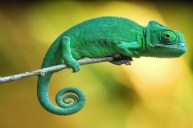This veiled chameleon isn't for children or novice reptile owners. They tend to be aggressive!
The Spruce Pets tells us that veiled chameleons are hardy, striking-looking lizards with tall casques (helmet-like structures) on the tops of their heads! What are these used for?
"The casque aids in steering water that falls onto their heads into their mouths. Veiled chameleons have bodies that are banded in shades of green, yellow and brown which adjust to varying shades."
Another fun fact? Veiled chameleons have specialized cells in the skin that allow color change.
Breed overview
LaFeber Vet provides some details about this unique breed. Unfortunately, these reptiles don't live all that long!
- Males are brightly colored, ranging from blue-green to green or yellow in appearance.
- Males are 18-24 inches long, while female "veileds" typically measure up to 14 inches long.
- Females typically live 3-5 years; the average male lifespan is 4-6 years.
Behavior and temperament
Experts at Pet MD tell us that veiled chameleons tend to be on the aggressive side, even when captive-born and bred. Make sure you have experience with reptiles before considering this type of chameleon.
"They don't enjoy being handled and the jury is still out on whether or not they can be successfully tamed. As long as you know these facts and respect the veiled chameleon's temperament before purchasing one, you'll be able to maintain a happy and successful pet-owner relationship."
Habitat and environment
Pet MD also tells us that veiled chameleons are solitary creatures and should be housed separately from each other in as large a cage as possible. The housing requirements are:
- A solid enclosure, the best choices of which are made entirely out of screening
- Adequate lighting and heating
- Regular water in the form of misting
Feeding and water
You can feed veiled chameleons crickets that are as long as your chameleon's head is wide. As they get older, you can feed them slightly less often. Adults can be fed every other day.
Dust your chameleon's food with a calcium supplement every other week to make sure they're getting all the proper nutrients.
They also won't drink from water bowls so you'll need a drop system setup.
How do you choose your veiled chameleon?
It's always best to go to a reputable breeder!
We decided to provide a quick section on overall veiled chameleon care for pet owners:
- Remember that they don't drink from water bowls. You'll need a misting system or a drip system so research your options with pet experts.
- All insects should be gut loaded.
- You must dust insects with a calcium/vitamin D3 supplement two to three times a week.
- A multi-vitamin and mineral supplement can be added once a week.
- Veiled chameleons are typically fed a variety of gut-loaded insects such as crickets, mealworms, superworms, waxworms, grasshoppers, silkworms and Madagascar roaches of appropriate size.
- Veiled chameleons also enjoy blossoms and leaves such as hibiscus, dandelions, ficus, romaine and escarole. Make sure you choose non-toxic plants of course.
- To make crickets more nutritious, which will benefit your veiled chameleon, gut-load them with such as collard greens, mustard greens, squash, orange and/or commercial cricket diets.
- The best source of UV light is always natural, unfiltered, sunlight.
- What about a heat source? A basking spot or basking area of up to 105 degrees should be the hottest part of your chameleon's cage. The rest of the cage should fall somewhere between 80-85 degrees, never dropping below about 72.
- What about the chameleon's enclosure? Chameleons should never be kept in a glass terrarium or aquarium. They need the ventilation that a mesh enclosure provides.
- What about health issues? Metabolic bone disease, a result of insufficient UVB light, is another common condition among veiled chameleons.
All of this should be on your veiled chameleon care sheet. Good luck!
Do you live with a chameleon? What essentials did we miss? Please leave us a comment below!
WATCH NOW: Bearded Dragons Are Awesome Reptiles!




